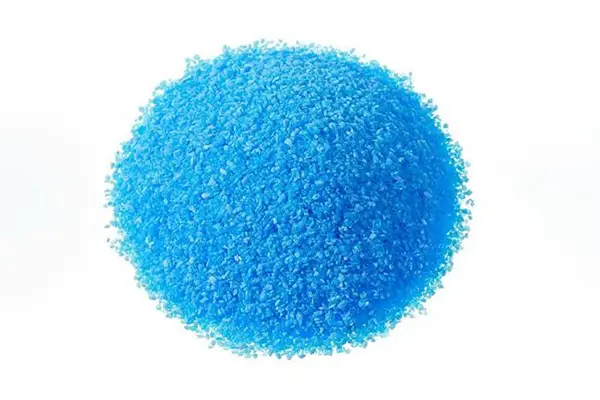Copper sulfate crystals are versatile compounds widely used across various industries and applications. With their striking blue color and broad functionality, they are essential in agriculture, chemistry, and even art. This article explores the many uses of copper sulfate crystals, shedding light on their importance and versatility.
What Are Copper Sulfate Crystals?
Copper sulfate, chemically known as copper(II) sulfate (CuSO₄), is a salt that appears in a crystalline form when combined with water. The most common form is pentahydrate (CuSO₄·5H₂O), which gives the crystals their characteristic vibrant blue color. Copper sulfate is produced by combining copper with sulfuric acid, resulting in a water-soluble compound with numerous applications.

Applications of Copper Sulfate Crystals
1. Agriculture
One of the primary uses of copper sulfate crystals is in agriculture, where they serve multiple purposes:
- Fungicide and Algaecide:
Copper sulfate is a common ingredient in fungicides to control fungal infections in crops, such as blight and mildew. It is also used to treat algae in ponds, irrigation systems, and reservoirs. - Soil Amendment:
Copper is an essential micronutrient for plant growth. Copper sulfate crystals are sometimes added to soil to correct copper deficiencies, improving plant health and productivity. - Animal Feed Supplement:
Copper sulfate is added in small amounts to livestock feed to prevent deficiencies, support growth, and enhance overall health.
2. Water Treatment
Copper sulfate crystals effectively control algae and aquatic weeds in water bodies, including ponds, lakes, and reservoirs. When applied in appropriate amounts, it inhibits algal growth, improving water quality for irrigation, recreational, and industrial use.
3. Industrial Applications
In industrial processes, copper sulfate crystals play a significant role:
- Electroplating and Electroforming:
Copper sulfate is used in electroplating to deposit a layer of copper onto metals, providing protection and a decorative finish. It is also used in electroforming, where copper is shaped into specific designs. - Mining and Ore Processing:
It acts as a flotation reagent in mining to separate valuable minerals from ore, particularly in the extraction of copper.
4. Education and Chemistry Experiments
Copper sulfate crystals are commonly used in chemistry labs for educational purposes. They are ideal for demonstrating:
- Crystallization Processes:
Students can observe how the crystals form when a copper sulfate solution cools or evaporates, offering insights into chemical structures. - Chemical Reactions:
Copper sulfate is often involved in experiments to illustrate principles such as displacement reactions and redox processes.
5. Medical and Veterinary Uses
In medicine and veterinary care, copper sulfate is used in controlled doses for:
- Antimicrobial Treatments:
It is a topical antifungal agent for skin infections and hoof rot in livestock. - Antiseptic Properties:
Diluted solutions of copper sulfate can act as a disinfectant for wounds in animals.
6. Artistic and Decorative Uses
The vibrant blue color of copper sulfate crystals makes them popular in arts and crafts. They are used to create unique artworks, decorative displays, and even as a colorant in glassmaking and ceramics.
Safety and Precautions
While copper sulfate crystals are highly useful, they must be handled with care due to their potential toxicity:
- In Agriculture:
Overapplication can lead to copper accumulation in soil, harming plants and aquatic life. - In Water Treatment:
Improper dosing can be harmful to fish and other aquatic organisms. - Personal Safety:
Direct contact with copper sulfate can cause skin irritation, and ingestion can lead to severe health issues. Always follow safety guidelines when handling this compound.
Environmental Impact
Copper sulfate has both positive and negative environmental impacts. When used correctly, it improves agricultural productivity and water quality. However, excessive or improper use can lead to environmental contamination, affecting soil health and aquatic ecosystems. Sustainable practices and precise application are crucial to mitigating these risks.
Conclusion
Copper sulfate crystals are indispensable in modern industry and agriculture, thanks to their multifunctionality and effectiveness. From controlling algae in water bodies to enhancing crop health and enabling scientific discoveries, these crystals are a testament to chemistry’s ability to solve practical problems. However, their usage requires responsible handling and adherence to safety protocols to maximize benefits while minimizing risks.
Post time: Dec-12-2024










